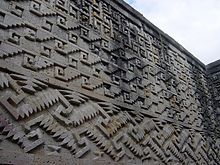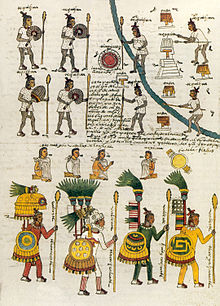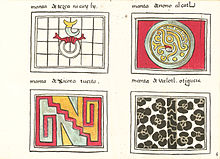Xicalcoliuhqui

Xicalcoliuhqui (also referred to as a "step fret" or "stepped fret" design and greca in Spanish) is a common motif in Mesoamerican art.[1][2][3][4] It is composed of three or more steps connected to a hook or spiral, reminiscent of a "greek-key" meander.[5] Pre-Columbian examples may be found on everything from jewelry, masks, ceramics, sculpture, textiles and featherwork to painted murals, codices and architectural elements of buildings.[6][7][8] The motif has been in continual use from the pre-Columbian era to the present.[2][9]

Connotations
The word xicalcoliuhqui (Nahuatl pronunciation: [ʃikaɬkoˈliʍki]) means "twisted gourd" (xical- "gourdbowl" and coliuhqui "twisted") in Nahuatl.[1][2][10] The motif is associated with many ideas, and is variously thought to depict water, waves, clouds, lightning, a serpent or serpent-deity like the mythological fire or feathered serpents, as well as more philosophical ideas like cyclical movement, or the life-giving connection between the light of the sun and the earth, and it may have been a protection against death, but no single meaning is universally accepted.[2][6][9] It is also possible that the motif represents the cut conch shell which is an emblem of Ehecatl, the wind god, an aspect of Quetzalcoatl.[6][11] It seems likely that the multivalent nature of the symbol gave rise to its potency and longevity.[6]
Xicalcoliuhqui chimalli, the stepped-fret shield

Xicalcoliuhqui chimalli, are shields featuring a single iteration of the stepped fret motif which were painted or covered with featherwork.[4] They are depicted frequently in the Codex Mendoza, and many other central Mexican codices, usually with the xicalcoliuhqui design shown in yellow and green.[2]
Architectural embellishments

The xicalcoliuhqui motif appears in embellishments on temples and other buildings at archaeological sites around Mexico.
- The xicalcoliuhqui motif is featured on either side of the staircase on The Pyramid of the Niches at the Veracruz site of El Tajín.[12]
- The stone mosaic fretwork at Mitla, a Zapotec site in Oaxaca, display many variations on the xicalcoliuhqui motif.[6]
References
- ^ ISBN 9004217452. pg 69
- ^ ISBN 0520908694. pg 190, 193
- ISBN 0884021106. pg 229.
- ^ ISBN 1780967578pg 20, 22.
- ISBN 0486200841pg. 21-30
- ^ ISBN 0884020991pg. 6-10.
- ISBN 0520028910pg 166.
- ISBN 9683647421. pg. 103
- ^ ISBN 1407303457. pg ii
- ^ de Sahagún, Fray Bernardino. ‘ ‘Primeros Memoriales’ ‘ ed. Sullivan, Thelma D. et al. University of Oklahoma Press, 1997, pg 99
- ISBN 0826340229. pg 339
- ISBN 0313349487pg. 35.



